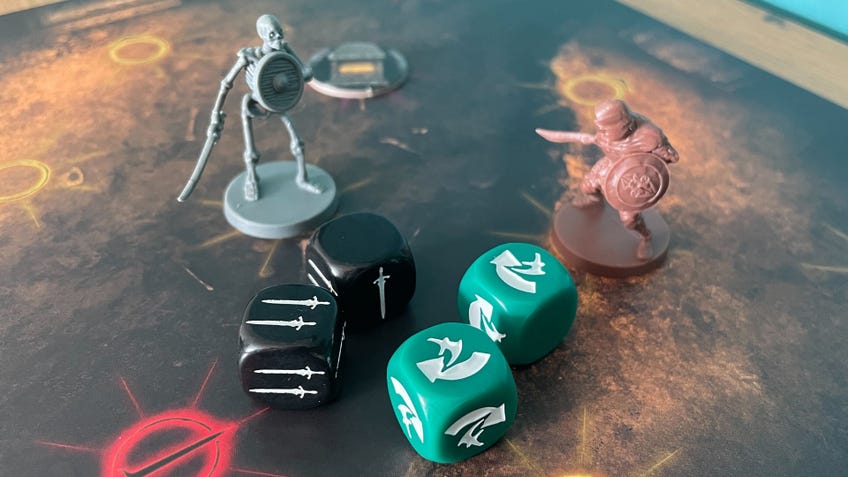Dark Souls: The Board Game’s revised edition fixes many of the original’s flaws, but introduces a few of its own
A definite improvement, at a cost.
Dark Souls: The Board Game was a mess. Released in 2017 after a then record-breaking Kickstarter campaign, the adaptation of the legendarily punishing video game was a disappointing exercise in style over substance.
It had its highlights - among them a clever node-based movement system for fluid, tactical positioning during combat and the dynamic behaviour of bosses, powered by an evolving deck of attack cards that replicated multi-stage video game fights - but they were too often lost between long hours of grinding for souls to level up, the need to hunt for useful equipment in a randomised treasure deck and suffering at the whim of dice rolls. The result was something that looked like Dark Souls, but felt like a slog and was punishing for all the wrong reasons.
The original game was something that looked like Dark Souls, but felt like a slog and was punishing for all the wrong reasons.
Fairly quickly after its release, a number of enterprising players seized on the game’s underutilised box of pixel-perfect miniatures and the unfulfilled promise of its gameplay and started to create their own house rules, aiming to cut down on the grind and reliance on luck to focus on the challenging, tense battles underneath. A number of variants and impressive custom mods emerged over the years, including prominent rebuilds like Santuric’s Hollowed Edition.
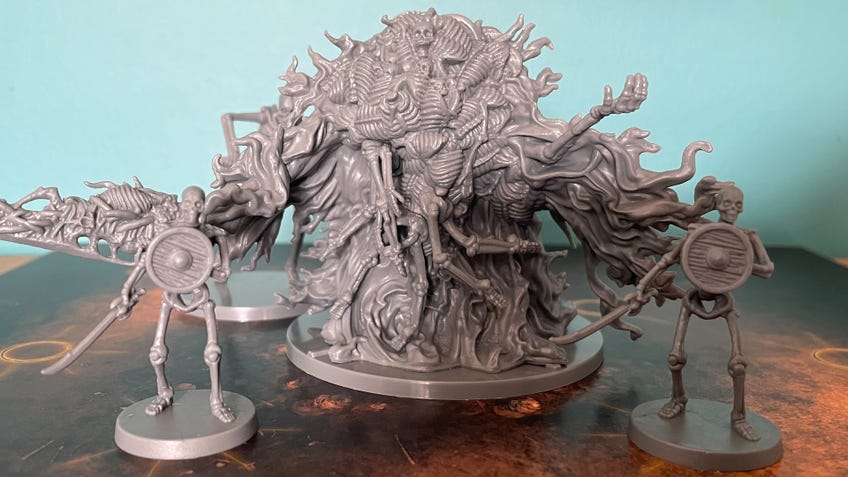
Now, publisher Steamforged Games has decided to rewrite Dark Souls: The Board Game’s rulebook itself, releasing a revised edition that the studio says has been (re)designed based on community feedback.
The rules aren’t all that’s new in the re-release. Replacing the original game’s single core set - which included half a dozen bosses and two campaigns loosely based on Dark Souls 1 and 3 - are two separate standalone boxes based on levels in the video game series’ first instalment.
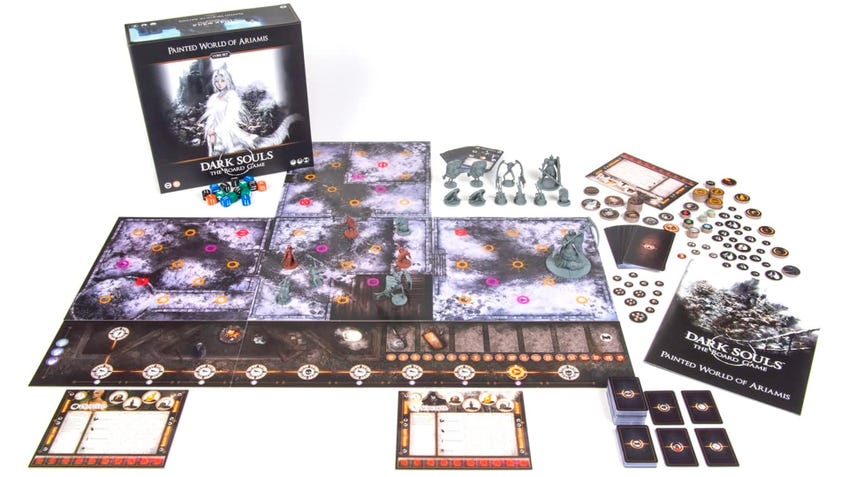
Tomb of Giants sees players venture into the dark, skeleton-filled catacombs in search of Gravelord Nito, while Painted World of Ariamis explores the snowy region home to Crossbreed Priscilla - an arguably odd choice for a debut release, given that Ariamis is an easily-missed optional side area in Dark Souls. Still, the two stand out as being among Dark Souls’ more memorable areas. Each box includes a selection of smaller enemies, plus a mini-boss and Nito or Priscilla, along with three playable characters drawn from Dark Souls’ starting classes. (The new rules are fully compatible with the original game and can be combined with the older box to support a full party of four.)
Despite packing in less plastic than the original Dark Souls: The Board Game box - which came with three mini-bosses and three main bosses, including two separate models to use in the fight against Ornstein and Smough - the new revised sets cost almost as much. Each will set you back £110 - £20 shy of the original’s £130 RRP (around £160 in today’s money, adjusted for inflation), but a good wad of cash more than a copy of the 2017 edition will typically cost you today. There are also fewer map tiles, fewer cards and one fewer player characters in the newer boxes.
Making the reduction in pure quantity even more egregious is that quality seems to have taken a hit, too. Instead of using wooden cubes to track your character’s stats as they level up, the character boards in the revised edition require you to hold on to the miniscule cardboard squares you punch out of each numbered slot, the fiddly new system asking you to flip them over and reinsert them into the board during play to determine your level. (In a similar way, health and stamina are awkwardly tracked by tiny punchboard tokens that clumsily sit diagonally over their square holes.)
Production issues detract from the sense of this revised edition polishing things up.
It’s a baffling decision that feels like a misguided cost-saving exercise, made that much worse by the lack of any in-box reference to the order in which each character’s unique stats go (the info was later released in an official errata document) - so if the squares fall out in the box, you’ll have to try and work out what goes where. Speaking from experience, it’s a convoluted, frustrating solution.
Other production issues also detract from the sense of this revised edition polishing things up. In our copy of Tomb of Giants, we spotted at least one misprinted token, the heroic action marker identical on both sides rather than showing used and unused icons crucial to gameplay. The tokens placed on players’ character boards to track their estus flask and other consumable items are also larger than the icons on the board, resulting in a messy squeeze.

These presentation and production issues are especially disappointing, because the revised edition otherwise does manage to deliver on its promise of improving on the Dark Souls board game’s much-maligned gameplay.
Among the biggest and best changes to the game is the introduction of a new campaign board that turns fights into standalone encounters. Where the original game saw players working their way between four rooms laid out on the table, battling their way towards the final boss, the revised edition makes each ‘room’ a separate instance along the campaign path.
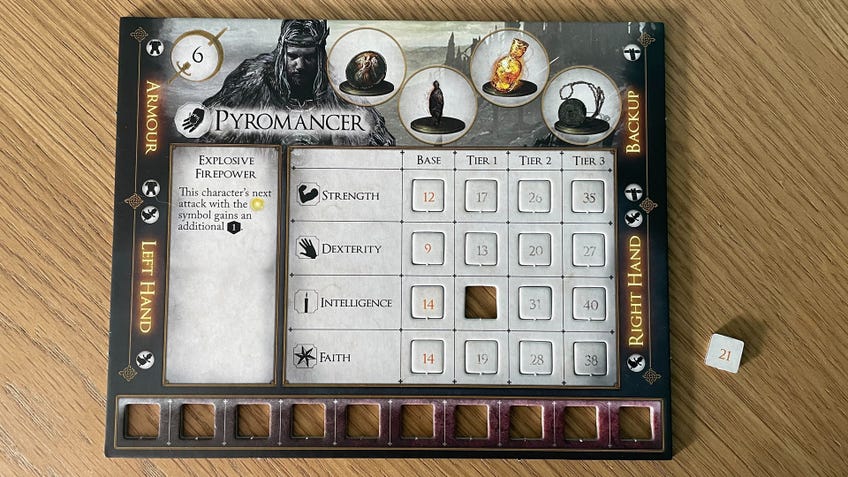
This not only makes it easier to pause and resume the game thanks to faster setup times for each encounter - helping mitigate the original’s gruellingly long playtime - it also allows each scenario to feel much more meaningful.
The revised edition does deliver on its promise of improving on the Dark Souls board game’s much-maligned gameplay.
A major part of this is the reworked deck of encounter cards that add atmospheric text and specific objectives to each fight, along with a new set of event cards drawn after each encounter. Encounter goals now go beyond simply ‘kill everything’ to include timed survival as players attempt to hold out for a set number of rounds, the need to hold a node on the board for a certain amount of turns king-of-the-hill-style, the task of activating levers around the map and more dynamic battles where a specific enemy needs to be defeated, but may summon in smaller foes to get in the way - such as a necromancer and their undead minions.
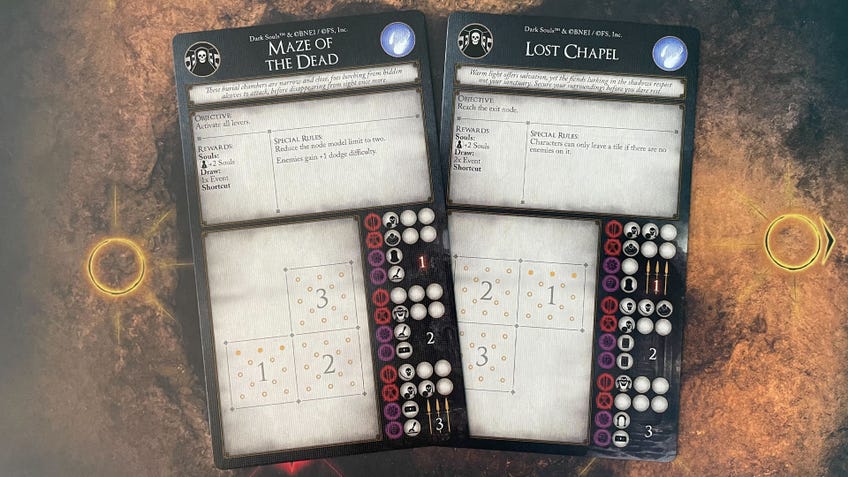
Combat was always the star of Dark Souls: The Board Game, but the smaller fights always felt like a means to an end as you ground out souls to level up for the boss, rather than being memorable in themselves. The revised edition manages to make each fight distinct and enjoyable in itself, giving the impression of a game that has a more even level of narrative and variety throughout, rather than saving all of its highlights for the end.
That’s not to say that the grind is completely eliminated. As before, players must rest back at the starting bonfire in order to cash in their collected souls and level up - or when they die, putting their unspent souls in peril. Doing so resets all of the encounters completed so far, which must be tackled again to make your way back along the campaign path.
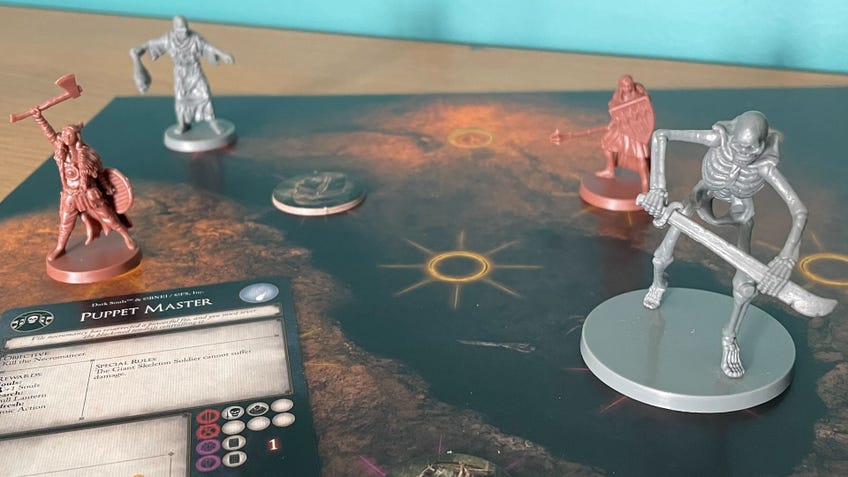
However, the new game introduces some smart encouragement to push your luck, adding the chance for shortcuts to encounters to appear (players get to choose one of two encounter cards drawn for each step). Defeating the mini-boss halfway along the campaign track also unlocks a second bonfire, reducing the deflating feeling of being sent back all the way back to the start on a later level.
The revised edition has a more even level of narrative and variety throughout, rather than saving all of its highlights for the end.
Echoing a popular community mod that doubled soul values, souls are also more plentiful than before - in the number earned for completing scenarios, and via events, optional ‘trial’ objectives and a new rule that rewards souls for barrels left unbroken at the end of an encounter. This means that grinding the same encounters to level up is less of a requirement, and returning to the bonfire typically feels more rewarding - as well as cutting down on the overall time taken to prepare for the final boss.
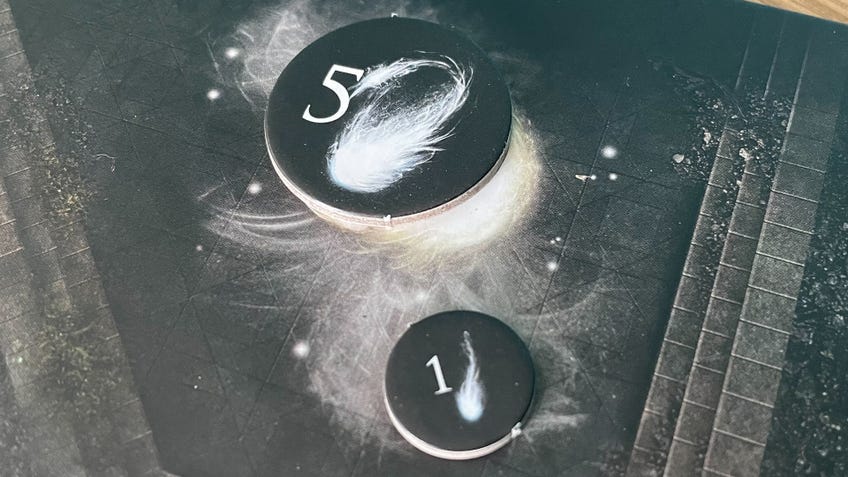
One of the original game’s other major missteps was in the treasure hunt, with players having to spend precious souls to draw random loot - some of which they were likely to be unable to use, leading to an unrewarding sense of churning through the deck to find gear you could actually equip. Now, players draw four cards from the deck into Blacksmith Andre’s marketplace, allowing the whole party to see what’s available and consider whether it’s worth the cost.
While I’m still not a big fan of the way that stats level up to arbitrary numbers - made worse here by the poor character board design - the increased control over what gear you gain is a significant improvement, remedying one of the worst parts of the original ruleset. It’s a small change with a major impact on the player experience.
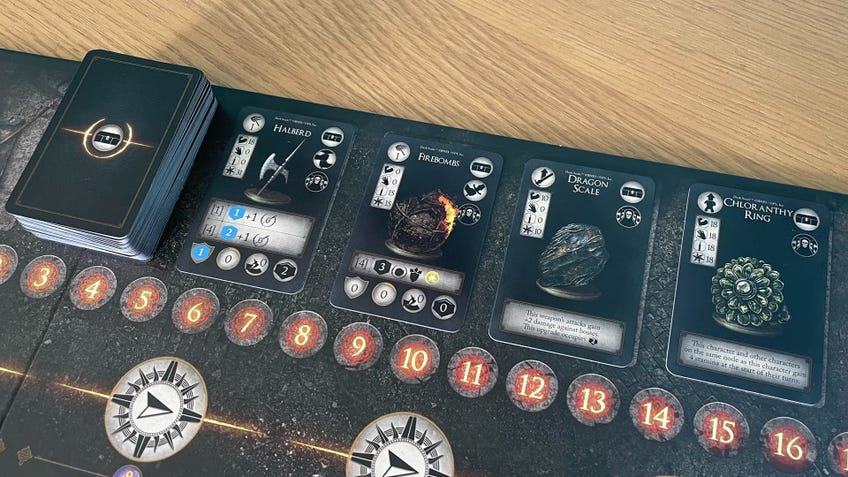
Though combat was arguably the part of Dark Souls: The Board Game that needed the least polishing, the revised edition makes a number of small yet important tweaks to help it flow along.
The new game makes a number of small yet important tweaks to help combat flow along.
Notably, dodging and blocking have been combined into a single roll, rather than being calculated individually - previously, the optional dodge replaced a block, but cost stamina to perform. Players roll dice based on their equipment’s defence against physical or magical attacks, with the chance to dodge completely out of the way or take reduced damage if they are hit. (In general, players are a smidge more survivable, thanks to a tiny rule change that results in death when their health/stamina bar would place another token and there’s no space, rather than immediately when it fills up.)

While it dampens the risk-reward decision of whether to block or dodge at the cost of stamina - something that Dark Souls purists may feel is key to its combat - creating a single roll streamlines the way that attacks are resolved, making the back-and-forth of fights flow more quickly and removing the need to spend stamina on dodging rather than attacks.
In general, stamina is much more forgiving in the revised rules. Rather than needing to choose whether they skip their attack to recover more stamina, players now just recover a set amount at the start of their turn, avoiding entire rounds spent taking a breather. Again, it’s a move away from the more video game-faithful stamina management of the original that may prove divisive among those committed to a hardcore difficulty, but it makes better sense in a board game where entire turns spent refilling your stamina felt tiring rather than tense.

This combines with the new ability for the rest of the party to move one node at the end of another player’s turn. It’s another small tweak that offsets the downtime between your own turns, as well as allowing increased flexibility in avoiding enemy attacks, providing a way of physically evading in place of the dedicated dodge roll.
The changes add up to make Dark Souls’ combat not a different beast, but a slightly more docile one.
These changes add up to make Dark Souls’ combat not a different beast, but a slightly more docile one. The increased movement of characters, more generous stamina and defence result in a more forgiving experience than the sometimes brutal nature of the original game - something that will either feel like a relief or a disappointment, depending on how you define your own sense of fun. For me, the changes are for the better, keeping the tactical puzzle combat that shone through in the original intact but with some of the slightly rougher edges smoothed down.
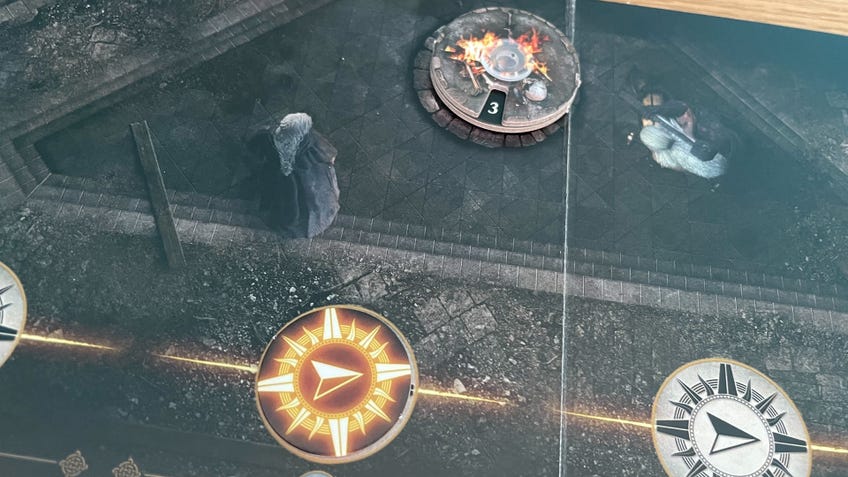
The improvements in the revised Dark Souls: The Board Game manage to ultimately redeem one of tabletop’s most infamous missed opportunities. Big and small, the changes add up to a vastly better experience on the tabletop. While they don’t entirely strip away the randomness and grind of the original, the game’s most frustrating excesses are honed into a sharper ruleset, better balancing its standout moments against an overall experience that feels far more considerate of players’ time and attention.
The revised Dark Souls: The Board Game manages to ultimately redeem one of tabletop’s most infamous missed opportunities.
While the game itself is inarguably better, though, that consideration doesn’t always extend to the overall package on offer in Tomb of the Giants and Painted World of Ariamis. The new boxes are let down by some disappointing production oversights and a price tag that is harder to stomach - especially for those once bitten.
Five years on, Dark Souls: The Board Game feels much closer to the game it was meant to be. It’s still not perfect, but these revised editions succeed in making good on more of the promise of the video game adaptation. In doing so, they might well rekindle the legacy of a fire many had considered to have gone out.
